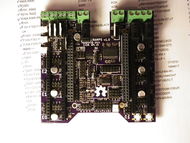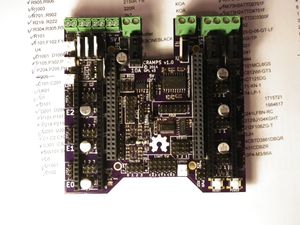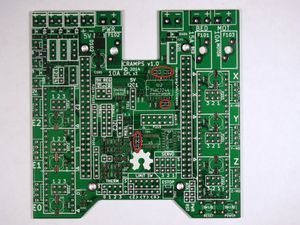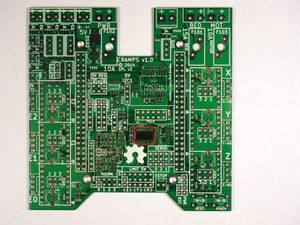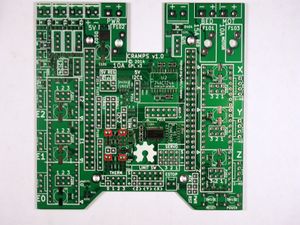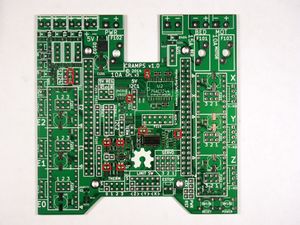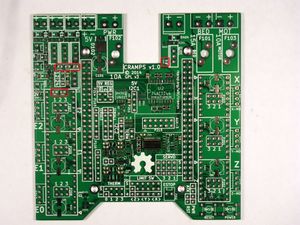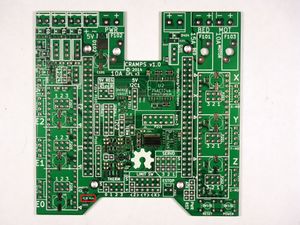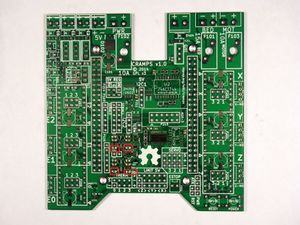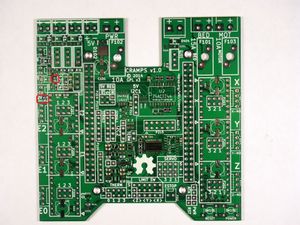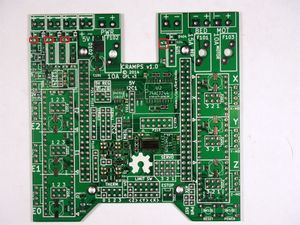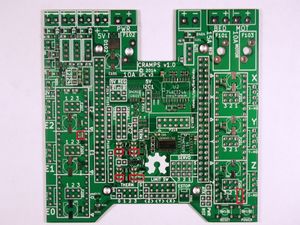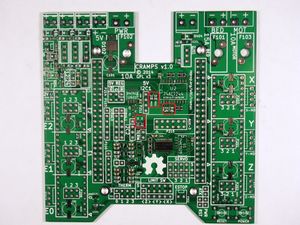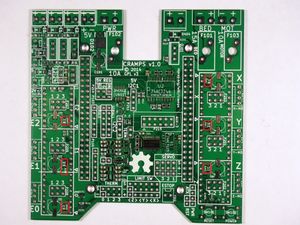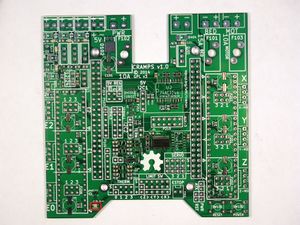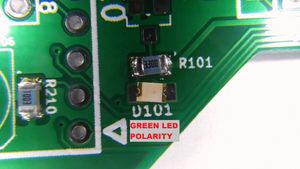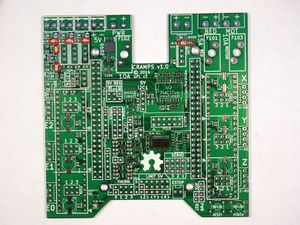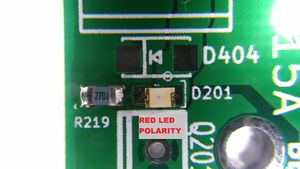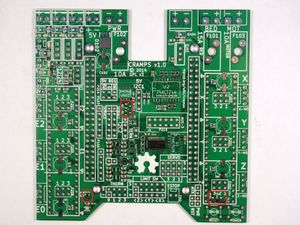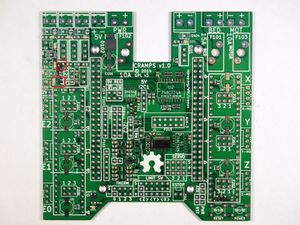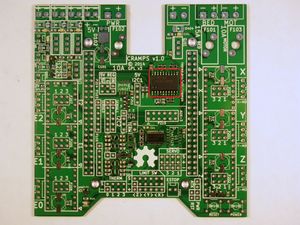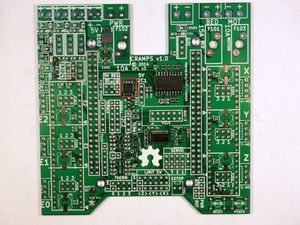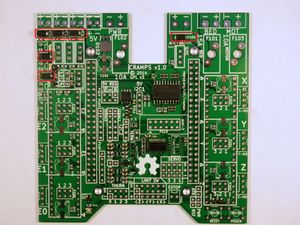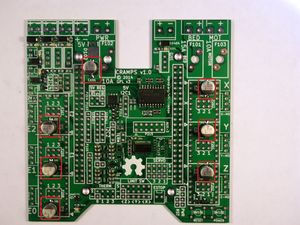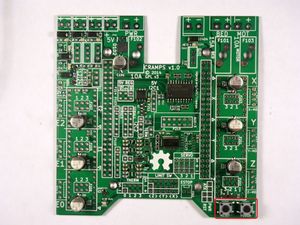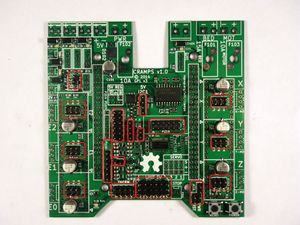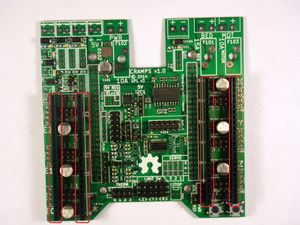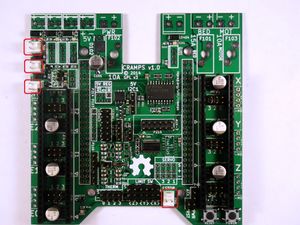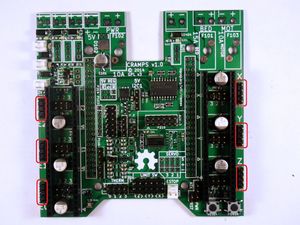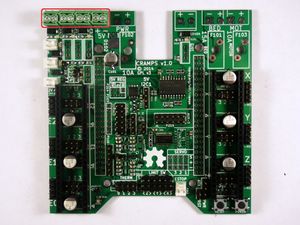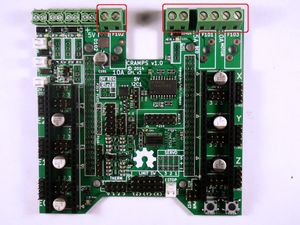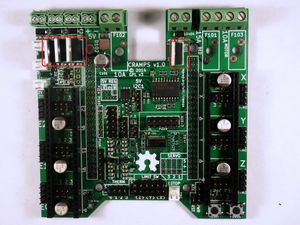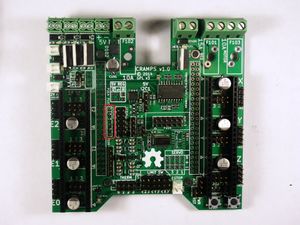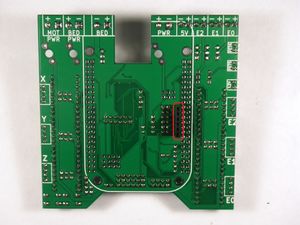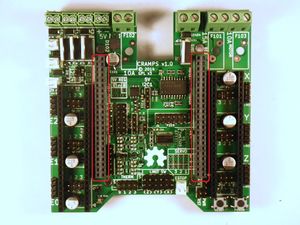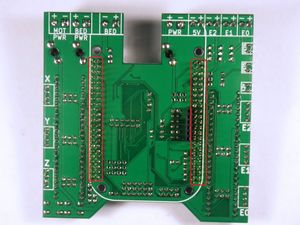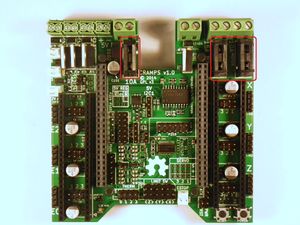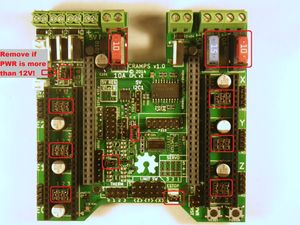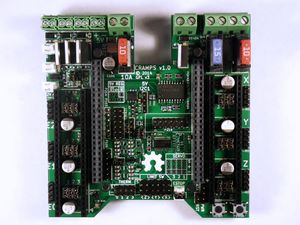CRAMPS1.0
Release status: Working
| Description | Cape-RAMPS for BeagleBone
|
| License | GPL
|
| Author | |
| Contributors | |
| Based-on | |
| Categories | |
| CAD Models | KiCAD
|
| External Link |
Contents
- 1 Summary
- 2 Safety
- 3 ECOs
- 4 Assembly
- 4.1 Required Tools
- 4.2 Cape Assembly
- 4.2.1 Fine Pitch SMT
- 4.2.2 Surface Mount Parts
- 4.2.2.1 C301 C302 C303 C501 : 10 uF 10V 0805 Capacitor
- 4.2.2.2 C1 C2 C102 C207 C305 C502 C503 C504 C505 C601 : 100 nF 35V 0805 Capacitor
- 4.2.2.3 R701 R702 R703 R704 R901 R902 : 220R 0805 Resistor
- 4.2.2.4 R101 : 330R 0805 Resistor
- 4.2.2.5 R301 R302 R303 R501 : 2k0 1% 0805 Resistor
- 4.2.2.6 R905 R906 : 1k8 0805 Resistor
- 4.2.2.7 R219 R220 R221 R222 : 2k7 0805 Resistor
- 4.2.2.8 R304 R305 R502 R503 R504 R505 : 4k7 0805 Resistor
- 4.2.2.9 R1 R2 R211 R212 R401 R402 : 10k 0805 Resistor
- 4.2.2.10 R201 R202 R203 R207 R208 R210 : 100K 0805 Resistor
- 4.2.2.11 D101 : Green 0805 LED
- 4.2.2.12 D201 D202 D203 D204 D901 D902 : Red 0805 LED
- 4.2.2.13 Q1 Q2 Q101 Q401 Q402 : 2N7002K FET
- 4.2.2.14 Q901 Q902 : DMN2075U
- 4.2.2.15 U2 : 74ACT244
- 4.2.2.16 U601 : 24C512
- 4.2.2.17 D401 D402 D403 D404 D903 D904 : ES1F
- 4.2.2.18 C101 C201 C202 C203 C204 C205 C206 : 100 uF
- 4.2.3 Through Hole Parts
- 4.2.3.1 SW101 SW102 : Pushbutton
- 4.2.3.2 Various Reference Designators : Pin Headers
- 4.2.3.3 U201 U202 U203 U204 U205 U206 : Pololu Sockets
- 4.2.3.4 P105 P302 P901 P902 : 2-pin KK Headers
- 4.2.3.5 P204 P205 P206 P210 P212 P217 : 4-pin KK Headers
- 4.2.3.6 P218 P219 P403 P405 : 3.5mm Screw Terminal
- 4.2.3.7 P101 P107 P108 P404 : 5.0mm Screw Terminal
- 4.2.3.8 Q201 Q202 Q203 Q206 : IRLB8743PBF
- 4.2.3.9 P103 : Serial Header
- 4.2.3.10 U4 : BeagleBone Headers
- 4.2.3.11 F101 F102 F103 : Fuse Sockets
- 4.2.3.12 Shunts and Fuses
- 4.2.4 Complete
Summary
The CRAMPS board is a mixed surface-mount and through-hole design. There are a small number of fine-pitch components (the resistor networks and FET bus level translator). These parts are challenging but possible to solder by hand. All other parts are large pitch or through-hole, and are relatively easy to hand solder.
Safety
The CRAMPS board is designed to handle power levels capable of causing a fire. Be very careful with the initial board checkout, ideally using a power supply protected from short circuit and overload. Never operate your board unattended, and make sure all connected parts subject to heating (including the wires and connectors!) are far away from any potentially combustible material. Always use the proper fuses, and insure your smoke detector is working properly.
ECOs
Required Changes
Testing indicated the following changes need to be made to the initial design
- Do not populate the 1N4148 diodes (D1001 D1002 D1003 D1004 D1005 D1006 D1007 D1008)
- These diodes were intended to protect the analog input from overvoltage, but interfere with the thermistor readings. The diodes and associated circuitry will be removed from the next version and the user is advised to not connect thermistor inputs to voltages over 1.8V.
- Change 1.0K 1% resistors to 2.0K 1%
- The 2.0K value provides for a more even distribution of available ADC accuracy across the temperature range when used with a typical 100K thermistor
Optional Changes
- Do not populate the SS10P diode (D102)
- This is a protection diode designed to crowbar the power supply and blow the fuse if power is hooked up backwards. This part will be removed from the next PCB version under the assumption that if the user is intelligent enough to connect the other two high-current power supplies properly, they are intelligent enough to connect this supply properly as well.
- Do not populate U1001 - TLV431CDBZR
- Do not populate R1002 - 1k 1% 0805 Resistor
- Do not populate R1003 - 2150R 1% 0805 Resistor
- Do not populate R1004 - 12k4 1% 0805 Resistor
- These parts generate the clamping rail for the ADC protection diodes (which have been removed) so they do not need to be populated.
- Do not populate the 74ACT125 and associated Servo pin headers
- The servo driver and connectors will be removed on the next version of the PCB in order to simplify the design.
- Do not populate the 7812 regulator (U3)
- This regulator is being removed from the next version of the board as it is either useless (if running from 12V) or subject to thermal and over-current shutdown (running from 24V with each of the "low-power" FET outputs capable of up to 2A output).
Assembly
Required Tools
- You must have
- Solder iron, solder wire, good tweezers
- You really need
- Solder wick, solder sucker, flux pen
- Optional methods use
- Solder paste, hot plate or oven
Cape Assembly
Soldering the CRAMPS board includes both surface mount and through hole soldering.
The surface mount can be done a few ways. To hand solder, start by putting a small amount of solder on one pad. If you have flux, coat the soldered pad. Use the tweezers to hold the component down in position and heat the solder to tack the component into place (make sure the entire solder blob flows so you don't get a cold solder joint). Then solder the other pads. Also popular is using solder paste for pad by pad soldering, Oven Reflow (need link), and HotplateReflowTechnique
Solder the SMT components first, starting with the fine pitch parts then working through the parts from shortest to tallest. Then solder the through-hole parts on top of the board. Finally solder the pin headers on the bottom of the board.
Fine Pitch SMT
RP1 RP2 RP3 RP801 RP802 : 10K Resistor Network
These can be placed in any orientation.
U5 : 74CBTLD3861 - FET Bus Level Translator
Align pin 1 with the silk-screen notch on the PCB.
Surface Mount Parts
C301 C302 C303 C501 : 10 uF 10V 0805 Capacitor
These can be placed in any orientation.
C1 C2 C102 C207 C305 C502 C503 C504 C505 C601 : 100 nF 35V 0805 Capacitor
These can be placed in any orientation.
R701 R702 R703 R704 R901 R902 : 220R 0805 Resistor
These can be placed in any orientation.
R101 : 330R 0805 Resistor
These can be placed in any orientation.
R301 R302 R303 R501 : 2k0 1% 0805 Resistor
These can be placed in any orientation.
NOTE: These parts should be 2.0K, although the initial BOM calls for 1.0K
R905 R906 : 1k8 0805 Resistor
These can be placed in any orientation.
R219 R220 R221 R222 : 2k7 0805 Resistor
These can be placed in any orientation.
R304 R305 R502 R503 R504 R505 : 4k7 0805 Resistor
These can be placed in any orientation.
R1 R2 R211 R212 R401 R402 : 10k 0805 Resistor
These can be placed in any orientation.
R201 R202 R203 R207 R208 R210 : 100K 0805 Resistor
These can be placed in any orientation.
D101 : Green 0805 LED
Place with the cathode terminal (marked with a small dot) closest to the E0 Pololu socket.
WARNING The Red and Green LEDs are marked differently!
D201 D202 D203 D204 D901 D902 : Red 0805 LED
Place with the anode (marked with a small dot) away from the pad marked with a silkscreen line.
WARNING The Red and Green LEDs are marked differently!
Q1 Q2 Q101 Q401 Q402 : 2N7002K FET
Place aligned with the 3 pad SOT-23 footprint.
Q901 Q902 : DMN2075U
Place aligned with the 3 pad SOT-23 footprint.
U2 : 74ACT244
Align pin 1 with the silk-screen notch on the PCB.
U601 : 24C512
Align pin 1 with the silk-screen notch on the PCB.
D401 D402 D403 D404 D903 D904 : ES1F
Align cathode mark with silk-screen line on the PCB.
C101 C201 C202 C203 C204 C205 C206 : 100 uF
Align body notches with silk-screen outline on the PCB.
Through Hole Parts
SW101 SW102 : Pushbutton
These can be placed in any orientation.
Various Reference Designators : Pin Headers
Place and solder all the pin headers. I typically use break-away headers and divide them up as needed. Note the populated headers shown reflect the ECOs above and those parts being removed in the next revision are not populated. You may, however, populate all the pin headers if desired.
U201 U202 U203 U204 U205 U206 : Pololu Sockets
These can be placed in any orientation.
P105 P302 P901 P902 : 2-pin KK Headers
Place with friction lock away from the board edge. Alternately, standard pin headers or other connectors (2.54mm screw terminals, etc) can be used in place of the KK series headers shown.
P204 P205 P206 P210 P212 P217 : 4-pin KK Headers
Place with friction lock away from the board edge. Alternately, standard pin headers or other connectors (2.54mm screw terminals, etc) can be used in place of the KK series headers. This board is shown populated with standard pin headers.
P218 P219 P403 P405 : 3.5mm Screw Terminal
Place so the opening for the wire faces the board edge. You may also choose other connectors with the same mounting pitch.
P101 P107 P108 P404 : 5.0mm Screw Terminal
Place so the opening for the wire faces the board edge. You may also choose other connectors with the same mounting pitch.
Q201 Q202 Q203 Q206 : IRLB8743PBF
These must be orientated as in the picture. The tall heat sink tab of the MOSFET needs to be aligned with the double-line on the silk-screen.
P103 : Serial Header
This can be placed in any orientation. Note this part is mounted on the back side of the board and soldered on the front side.
U4 : BeagleBone Headers
These can be placed in any orientation. Be careful when soldering the extended pins that you only apply solder to the base of the pins. If you get solder on the end of the pins, it may not plug into your BeagleBone. Alternately, if you don't need stack-through support you can use standard pin headers placed on the back side of the board and soldered on the front side.
F101 F102 F103 : Fuse Sockets
These can be placed in any orientation.
Shunts and Fuses
Place the various shunts and fuses on the board. Note the choice of which shunts to populate depends on your operating choices. The picture shows what is expected to be the most common usage.
Complete
Assembly is now complete, hopefully your board looks something like this one.
